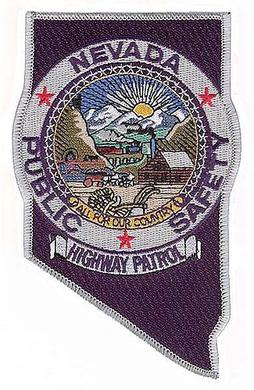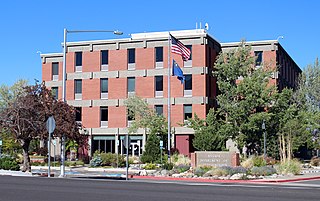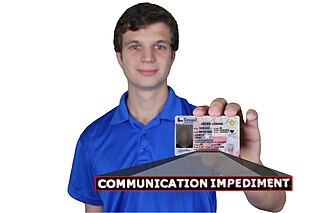
A department of motor vehicles (DMV) is a government agency that administers motor vehicle registration and driver licensing. In countries with federal states such as in North America, these agencies are generally administered by subnational entities governments, while in unitary states such as many of those in Europe, DMVs are organized nationally by the central government.
The Driver License Compact is an agreement between states in the United States of America. The compact is used to exchange data between motorist's home state and a state where the motorist incurred a vehicular violation. Not all states are members, and states respond to the data differently.

The Nevada State Police (NSP), also known as the Nevada Department of Public Safety (DPS) from roughly 1949 to 2021, is the state police and highway patrol agency of Nevada, with state-wide jurisdiction. The Nevada State Police encompass the Division of Parole and Probation, the Nevada Highway Patrol, the Capitol Police Division, the Division of Investigations, the Office of Professional Responsibility, the Fire Marshall Division and the Records, Compliance and Communications Division as well as various other smaller entities.

The Nevada Department of Transportation is a government agency in the U.S. state of Nevada. NDOT is responsible for maintaining and improving Nevada's highway system, which includes U.S. highways and Interstate highways within the state's boundaries. The department is notable for its aggressively proactive approach to highway maintenance. Nevada state roads and bridges have also been named some of the nation's best.

The California Department of Motor Vehicles (DMV) is the state agency that registers motor vehicles and boats and issues driver licenses in the U.S. state of California. It regulates new car dealers, commercial cargo carriers, private driving schools, and private traffic schools. The DMV works with the superior courts of California to promptly record convictions against driver licenses, and initiates administrative proceedings before its own administrative law judges to suspend or revoke licenses when drivers accumulate excessive convictions. It issues California license plates and driver's licenses. The DMV also issues identification cards to people who request one.
The Nevada Department of Education or NDOE, autonomous of the governor and the Nevada State Legislature, administers primary and secondary public education in the state of Nevada.
The Nevada Department of Conservation and Natural Resources (DCNR) is a Nevada state agency that focuses on the preservation and management of Nevada’s natural, cultural, and recreational resources. The current director is James Settelmeyer. The agency is headquartered in Carson City, Nevada. One of its holdings is the South Fork Dam and Reservoir near Elko, Nevada.

In the United States, driver's licenses are issued by each individual state, territory, and the District of Columbia rather than by the federal government due to federalism. Drivers are normally required to obtain a license from their state of residence. All states of the United States and provinces and territories of Canada recognize each other's licenses for non-resident age requirements. There are also licenses for motorcycle use. Generally, a minimum age of 15 is required to apply for a non-commercial driver license, and 25 for commercial licenses which drivers must have to operate vehicles that are too heavy for a non-commercial licensed driver or vehicles with at least 16 passengers or containing hazardous materials that require placards. A state may also suspend an individual's driving privilege within its borders for traffic violations. Many states share a common system of license classes, with some exceptions, e.g. commercial license classes are standardized by federal regulation at 49 CFR 383. Many driving permits and ID cards display small digits next to each data field. This is required by the American Association of Motor Vehicle Administrators' design standard and has been adopted by many US states. According to the United States Department of Transportation, as of 2018, there are approximately 227 million licensed drivers in the United States, making driver's licenses the primary method of identification in the United States.

The U.S. state of Nevada first required its residents to register their motor vehicles in 1913. Registrants provided their own license plates for display until 1916, when the state began to issue plates.

The U.S. state of Wisconsin first required its residents to register their motor vehicles and display license plates in 1905. Plates are currently issued by the Wisconsin Department of Transportation (WisDOT) through its Division of Motor Vehicles. Front and rear plates are required for most classes of vehicles, while only rear plates are required for motorcycles and trailers.
The Driver's Privacy Protection Act of 1994, Title XXX of the Violent Crime Control and Law Enforcement Act, is a United States federal statute governing the privacy and disclosure of personal information gathered by state Departments of Motor Vehicles.

The Florida Department of Highway Safety and Motor Vehicles (FLHSMV) is a statutorily established cabinet agency of Florida government. In 1969, under Governor Claude Kirk, the Department of Motor Vehicles and the Department of Public Safety were merged forming the Department of Highway Safety and Motor Vehicles. The agency head of FLHSMV is the governor and Cabinet, with authority delegated to the executive director. The executive director has functional responsibility for directing, monitoring, supervising, coordinating, and administering all activities of the department. The executive director ensures that FLHSMV's mission and objectives are being followed, pursuant to the Florida Statutes and Florida Administrative Code. The department provides oversight and services in partnership with the various 67 Florida county tax collectors for the issuance of driver licenses, the Florida drivers license handbook registrations and titling of automobiles, trailers, boats, and mobile homes. Florida residents who are at least 15 years old can obtain a learner license after meeting the requirements.

In the United States, vehicle safety inspection and emissions inspection are governed by each state individually. Fifteen states have a periodic safety inspection program, while Maryland requires a safety inspection and Alabama requires a VIN inspection on sale or transfer of vehicles which were previously registered in another state. An additional 16 states require periodic emissions inspections.
The Nevada Department of Health and Human Services (DHHS) is a state agency of Nevada, headquartered in Suite 100 of the 4126 Technology Way building in Carson City. The agency provides health services and human services.
The Nevada State Board of Medical Examiners is a state agency of Nevada that regulates and administers licenses to physicians, practitioners of respiratory care, physician assistants, and perfusionists who wish to practice in Nevada. The agency is headed by a board, with its current president being Rachakonda D. Prabhu. The Nevada State Board of Medical Examiners is headquartered in Reno, Nevada. It is a member of the Federation of State Medical Boards.
Driving under the influence (DUI) occurs when a person operates a motor vehicle while under the influence of drugs or alcohol, or when the driver has a blood alcohol level of 0.08 or greater. Minors and young adults aged 18–20 can be charged with impaired driving based on blood alcohol levels of 0.01 or higher, and CDL license holders can be charged based upon blood alcohol levels of 0.04 or higher.
The Nevada State Department of Taxation is a Nevada government state agency that mainly focuses on the collection and distribution of taxes in Nevada. Aside from its taxation-related duties, the agency also manages and regulates marijuana business licensing and property appraisals. The agency is headquartered in Carson City, and also operates offices in Reno, Las Vegas, and Henderson.
The State of Nevada Commission on Mineral Resources, also known as the Nevada Division of Minerals, is a Nevada state agency division that focuses on regulating geothermal drilling activities in Nevada, whether conducted in private or public lands. The division is currently headed by a chairman, and the position is currently occupied by Josh Nordquist. It is headquartered in Carson City and maintains an additional office in Las Vegas.
The Nevada Indian Commission is a Nevada state agency division that studies matters affecting the social and economic welfare and well-being of American Indians residing in Nevada. The division is part of the Department of Tourism and Cultural Affairs. It is led by an executive director, and the position is currently occupied by Stacey Montooth, who reports to both the commissioner and the governor. The division is headquartered in Carson City, Nevada.
The NevadaPublic Employees’ Benefit Program, also known as PEBP, is a Nevada state agency that manages and administers the health and life insurance programs for qualified employees of the Nevada government. The agency is currently headed by an executive officer, who reports to the PEBP board. The current executive officer is unlisted. The Nevada Public Employees' Benefit Program is headquartered in Carson City, Nevada.









